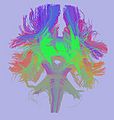2009 Summer Project Week FunctionalClusteringAnalysis
Key Investigators
- BWH: Doug Terry (dougt@bwh.harvard.edu), Marek Kubicki, Andrew Rausch, Lauren O'Donnell, David Tate, CF Westin
Objective
We are using the clusters that are automatically outputted from whole-brain tractography and whole-brain congealing/clustering to draw correlations based on anatomical connectivity to see if there are group differences between chronic schizophrenics and controls.
Approach, Plan
After whole brain tractography is completed for each case, the tracts for all the cases will be put through group coregistration/congealing. Then clustering takes place on the mean congealed brain. Specified number of clusters here is 200 for the whole brain, bilaterally. The clusters from the mean image are then transferred back to individual subject space. The mean FA/Mode/Trace will be taken from each cluster on each subject.
These diffusion values will then be correlated with clinical/neuropsych assessments. This is a way to look at possible deficits in schizophrenics without grouping the entire anatomical cluster together.
Progress
Each case has undergone whole-brain tractography. Group coregistration, congealing, and clustering has taken place and the results have been confirmed as anatomically accurate by Lauren O'Donnell. The most relevant neuropsychological and clinical measures are being selected by David Tate. Correlations between these values and diffusion measures will be run on automatically outputted clusters to see if there are any differences between the 2 subject groups.
For analysis, we are first looking at the data in 2 ways: 1) Within the Normal Controls, we will be measuring FA/Mode/Trace/Axial Diffusion/Radial Diffusion for all the 200 bilateral tracts and correlating them with neuropsychological tests since trends would be expect in a healthy population. 2) Divide each of the 200 clusters down the midsagittal plane to separate the bilateral clusters into left and right sides. Then correlate with neuropsych.
References
- O'Donnell L. Cerebral White Matter Analysis Using Diffusion Imaging. Ph.D. thesis, Massachusetts Institute of Technology, 2006.
- Whitford T, Kubicki M, King R, Khan U, Markant D, Alvarado J, McCarley R, Shenton ME. Abnormalities in tensor morphology in patients with schizophrenia: A dti study of the corpus callosum, 2009.


